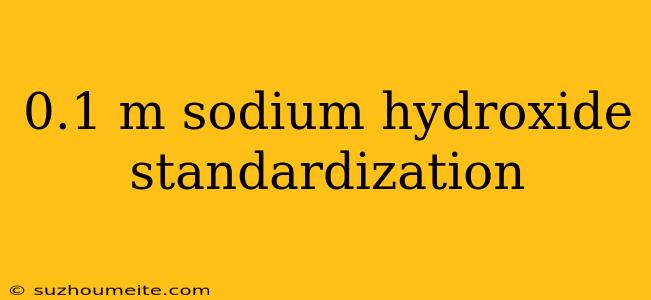0.1 M Sodium Hydroxide Standardization
Introduction
Sodium hydroxide (NaOH) is a strong base commonly used in various laboratory applications, including titrimetry. In order to use NaOH as a titrant, its concentration must be accurately known. This is achieved through standardization, a process whereby the concentration of NaOH is determined by reacting it with a primary standard acid.
Principle
The standardization of 0.1 M sodium hydroxide involves the reaction between NaOH and a primary standard acid, such as potassium hydrogen phthalate (KHP). The reaction is as follows:
NaOH + KHP → NaKP + H2O
The equivalence point of the reaction is determined using a suitable indicator, such as phenolphthalein, which changes color at a specific pH. By measuring the volume of NaOH required to reach the equivalence point, the concentration of NaOH can be calculated.
Materials
- 0.1 M NaOH solution
- Potassium hydrogen phthalate (KHP)
- Phenolphthalein indicator
- Distilled water
- Burette or pipette
- Erlenmeyer flask
Procedure
Preparation of KHP Solution
- Weigh accurately about 0.2-0.3 g of KHP into a 100 mL beaker.
- Add about 50 mL of distilled water to the beaker and stir until KHP is completely dissolved.
- Transfer the KHP solution to a 100 mL volumetric flask and make up to the mark with distilled water.
Standardization of NaOH Solution
- Pipette 25 mL of KHP solution into a 250 mL Erlenmeyer flask.
- Add 2-3 drops of phenolphthalein indicator to the flask.
- Titrate the KHP solution with the 0.1 M NaOH solution until the color changes from colorless to pink.
- Record the volume of NaOH solution required to reach the equivalence point.
- Repeat steps 1-4 at least three times to ensure accurate results.
Calculation
The concentration of NaOH solution can be calculated using the following formula:
Molarity of NaOH = (Mass of KHP / Molar mass of KHP) / (Volume of NaOH solution)
where:
- Mass of KHP is the weight of KHP used in the titration
- Molar mass of KHP is 204.22 g/mol
- Volume of NaOH solution is the average volume of NaOH solution required to reach the equivalence point
Results
The results of the standardization should be reported as the molarity of the NaOH solution, with an uncertainty estimate.
Conclusion
In this article, we have described the standardization of 0.1 M sodium hydroxide solution using potassium hydrogen phthalate as a primary standard acid. The standardization of NaOH is essential in analytical chemistry to ensure accurate and reliable results in titrimetric analyses.
